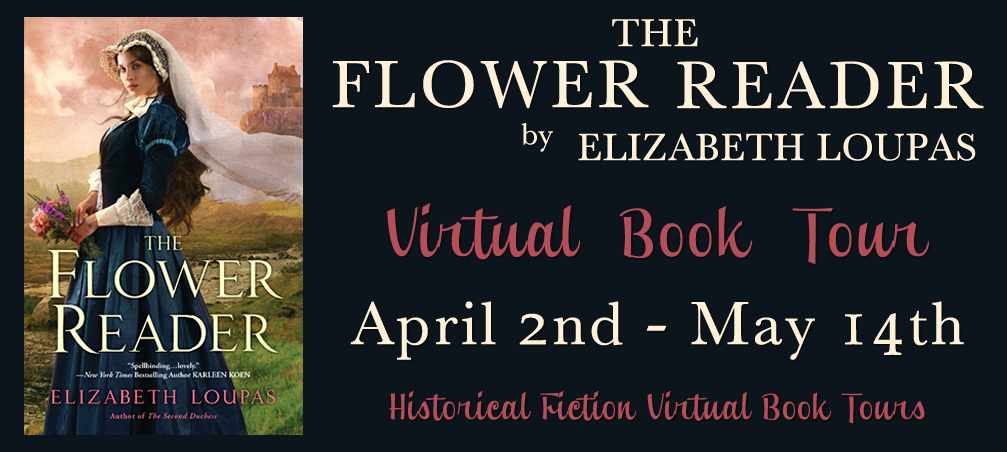
Please join me in welcoming Elizabeth Loupas, author of the new book, The Flower Reader to Always With a Book! If you missed my review, you can read it here. Today Elizabeth talks about the how she was able to write like Nostradamus.

WRITING LIKE NOSTRADAMUS
by Elizabeth Loupas
It’s hard to write about European courts in the sixteenth
century without at least some reference to Michel de Nostredame—Nostradamus.
His books of quatrains were kind of the Gawker.com of their day, particularly
the blind items. He had a knack for writing flowery, cryptic semi-poetical
French sprinkled with Latin, Greek, Italian and Provençal, which appeared to
make predictions but in actuality could mean just about anything. Probably his
most famous quatrain is:
Le lyon jeune le vieux surmontera,
En champ bellique par singulier duelle,
Dans
caige d’or les yeux luy crevera:
Deux
classes une, puis mourir, mort cruelle.
The young lion will overcome the old,
On a field of combat, in a single (or
unusual) duel,
In a cage of gold he will put out his
eyes,
Two wounds (“classes” is generally
taken to be an example of Nostradamus confusing the issue with ancient Greek,
in which “klasis” means “fracture”) in one, then to die, a cruel death.
Now this was originally published in 1555, and probably had
nothing at all to do with the French king Henri II, who died four years later
in 1559; in fact, in 1558 Nostradamus predicted a long and successful life for
Henri. But in hindsight (which is always so kind to prophets) there were some
startling coincidences:
1. Henri was wounded during a joust,
which could be considered a “single duel” on a “field of combat.”
2. His injuries included two splinters
from a broken lance, one piercing his throat, the other piercing his eye.
3. His opponent, the Count of
Montgomery, was a captain in the king’s Scots Guards—and the heraldic symbol of
Scotland is a red lion.
4. The king’s helmet might have had a barred
visor resembling a cage, and might have been gilded. He was the king, after
all. No one seems to have recorded these details at the time.
Coincidences or not, this single quatrain made Nostradamus’
reputation, at the time and down through the ages. So when I began to write
about a mysterious silver casket filled with secrets, connected with the
French-raised Mary Stuart in Scotland in the 1560s, what else could the secrets
possibly be but fictionalized quatrains of Nostradamus?
I considered never actually revealing the content of the
quatrains—writing in Nostradamus’ style is much trickier than it looks. But
then I said to myself, “Self, after readers have followed the mystery of the
silver casket through four hundred pages or so of adventures, they have a right
to know what’s in the darn thing.” And that’s how the fictional “Quatres-Maris” (“Four Husbands”) prophecies were born.
Marriages of royal persons at the time of the story were
legitimate political bombshells, and if the notorious seer Nostradamus
predicted that Mary Queen of Scots would have four husbands while she was still
married to her first one (who just happened to be the King of France), that
would indeed be explosive knowledge her political enemies—and friends, for that
matter, although in politics does anyone have real friends?—would lie, cheat,
steal and kill to possess.
I pored over the real quatrains of Nostradamus for a long
time, to get the right feel for the prophecies. And I do share them with the
reader, in the end. But as to how and why, and who the four husbands are—well, that
you will have to find out for yourself.

About the author: Elizabeth Loupas lives near the Elm Fork of the Trinity River,
halfway between Dallas and Fort Worth, Texas. She is presently a
novelist, freelance writer and amateur historian. In other times and
other places she has been a radio network vice president, a reference
librarian, a business-to-business magazine editor, and a tutor in
English literature.
One of her passions is the art and poetry of
the Pre-Raphaelites. This led her to the Rossettis and the Brownings,
and the project nearest and dearest to her heart–her novel THE SECOND
DUCHESS, based on Robert Browning’s poem “My Last Duchess.”
She
hates housework, cold weather, and wearing shoes. She loves animals,
gardens, and popcorn. Not surprisingly she lives in a state of happy
barefoot chaos with her delightful and faintly bemused husband (the
Broadcasting Legend), her herb garden, her popcorn popper, and two
beagles.
For more information on Elizabeth Loupas and her novels, please visit her WEBSITE. You can also find her on FACEBOOK and TWITTER.
Also, be sure to check out all the other stops on the blog tour and follow the tour on Twitter (hashtag: #FlowerReaderVirtualTour)
Thank you Elizabeth for contributing this great guest post and thanks to Amy at Historical Fiction Virtual Book Tours for coordinating it.